Orange Jams is a series of live sessions hosted by Orange & Jam in the Van which features Orange ambassadors from across the globe. This session sees Balto live at Jam in the Van’s L.A HQ.
Orange Jams is a series of live sessions hosted by Orange & Jam in the Van which features Orange ambassadors from across the globe. This session sees Kryptograf live at Polyfon Studio in Bergen.
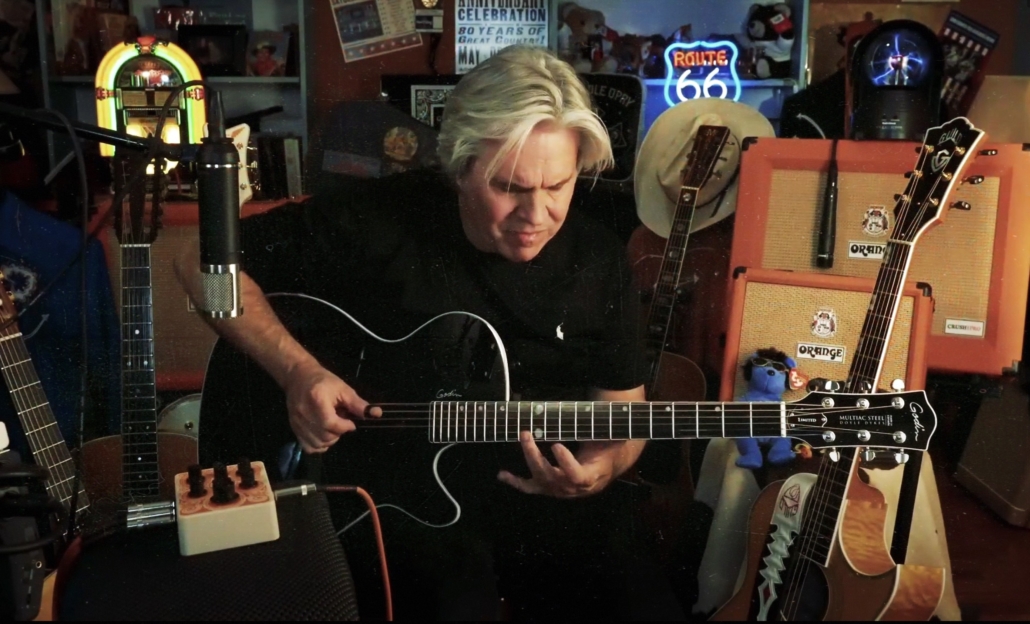
The Orange Acoustic Pedal takes all the know-how of our acclaimed Acoustic Pre TC preamp and Crush Acoustic 30 amplifier, cramming it all into a do-it-all, compact preamp pedal. Whether you need to win the battle against feedback, handle complex effects chains, brighten up a dull instrument or just plug into a PA, the Acoustic Pedal has you covered – in top-notch Orange style.
With a low-noise JFET circuit design, surgical-yet-flattering EQ, XLR and 1/4″ outputs and a buffered FX Loop, all situations are taken care of. This high-headroom, high-quality pedal keeps your setup simple and controlled, leaving you free to do what you do best. Play.
Here we’ve got American country guitarist and Orange ambassador Doyle Dykes both reviewing, and demoing the pedal: «It has the best mid-section I’ve ever seen on any pedal.»
Review above, demos below. Enjoy!
Celebrating the release of Beartooth’s latest single ‘Devastation’ bassist Oshie Bichar is giving us a runthrough of the tune through his OBC810.
The single is the first of their upcoming album ‘Below’, which will be out via Red Bull Records on the 25th of June.
Ever wondered just what the hell some people are on about in your local music store? If you have then fear no more as this time around the blog takes a look at a few of the more common terms, abbreviations and slang that guitarists use (both in the real world and cyberspace). So hopefully the next time someone says something using techno speak or jargon you’ll know exactly what they’re on about.
For ease of reference in an emergency (well you never know!) we’ve put everything in alphabetical order (plus it helps with our OCD…that’s Obsessive Compulsive Disorder just in case you’re wondering)!
Amp
Let’s start simple…amp is short for ‘amplifier’.
Axe
A slang term for a guitar.
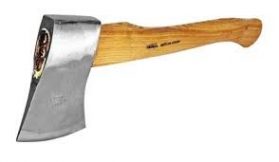
Not one of these…
Board
Not all of us dabble with pedals so this might not register with some…it’s simply short for ‘pedalboard’.
Cab
Speaker cabinet is a bit of a mouthful when you’re in a rush so more often than not it’ll get shortened to ‘cab’.
Cabs don’t come much better than this…
Combo
Short for combination amplifier i.e. an amp and speaker(s) in one enclosure rather than two separate units.
Much more portable but they can be heavy…
EQ
Short for Equaliser or Equalisation, it’s a reference to the section of your amps or pedals controls concerned with Treble, Middle and Bass.
FX
One of the few abbreviations that gives the game away as it sounds exactly like the word it replaces. Still haven’t figured it out? Ok…it’s short for ‘effects’.
Whether it’s a stand alone pedal, a multi-unit or rack-mounted; it’s all effects…
G.A.S.
Most guitar players will at some point in their life be struck down by the incurable disease that is ‘Gear Acquisition Syndrome’. There’s just never enough gear in the world to satisfy the thirst for a new bit of kit.
Gate
Not the kind you find in a field or outside your house. If someone’s talking about a gate they’ll be on about a Noise Gate such as Boss’ NS2 or MXR’s Noise Clamp.
HB
Another simple one…Humbucker (as in the pickup).
It’s a Humbucker; can’t really say a lot more…
Head
If you’ve ever heard someone who plays guitar say that their head blew up and you’re wondering how they’re still alive, it’s because they were making reference to their Amplifier Head (it’s an easy mistake to make!).
A prime example of an Amplifier Head…
HH / HSH / HSS
If you ever see this it’s simply referring to a guitar’s pickup configuration. HH means a pair of humbuckers. HSH means a pair of humbuckers with a single coil between them. HSS means a pair of single coils and a single humbucker (the latter is usually found in the bridge position).
A HSS Fender Strat…
Jack
Yes it may be a boy’s name but in the world of the guitarist it’s normally short for Jack-Plug or Jack-Socket.
J Bass & P Bass
A quick distinction between the two classic bass types. The J stands for ‘Jazz’ and the P for ‘Precision’.
On the left a Fender Jazz Bass and on the right a Fender Precision Bass…
LP
It’s only ever going to mean one thing…Les Paul.
Thank you Les…
MIA / MIJ / MIM
These abbreviations are most commonly used when talking about a guitar’s origin i.e. the country it was made in. MI stands for ‘Made In’ and then you add the first letter of the product’s country of manufacture, e.g. a guitar made in America would be MIA, whilst a guitar made in Mexico would be MIM.
NOS
‘New Old Stock’ refers to products or parts that a retailer has had lying about for ages but never sold. Because they can’t be specific as to their age and they don’t want to advertise falsely they get labelled as New Old Stock.
OD
Not to be confused with Over Dose, OD is a reference to the defining sound of classic rock…Overdrive.
PAF
PAF or ‘Patent Applied For’ is usually used in reference to an early model humbucker created by Seth Lover in 1955.
Pots
Nothing to do with plants at all but everything to do with ‘Potentiometers’ such as the Volume and Tone controls on your guitar.
This is what a pot looks like on the inside…
Pre-Amp
A Pre-Amp (short for preamplifier) is an electronic amplifier that prepares the signal for further amplification or processing. In a guitar amp the signal is fed into the pre-amp before reaching the power-amp.
Pup(s)
Although they’re undeniably cute we’re not talking about baby dogs here. What we’re actually on about is ‘pickups’.
The ‘original’ Tiny Terror…awww!!!
SS
If an amplifier isn’t a valve or tube amp then it’s most likely to be a ‘solid state’ amplifier such as Orange’s Crush Series.
Tab
A Tab (or tablature to give it its full name) is a form of musical notation commonly used for guitar that indicates instrument fingering rather than musical pitches.
Stack
What do you get when you put a load of speaker cabs and amp heads together? A stack!!!
Oh yes…
Strat & Tele
The majority of us will simply know them as Strats and Teles but that’s actually short for Stratocaster and Telecaster respectively.
Fender’s classic Stratocaster (Left) and Telecaster (Right)…
Stompbox
If you’re into effects this slang term will be very familiar. It’s simply a reference to a stand alone effects pedal such as Xotic’s EP Booster (i.e. not a multi-fx unit).
One of the smaller varieties…
Trem
Often used in place of Tremolo i.e. in reference to the effect or the somewhat mis-named arm fitted to some electric guitars.
Verb
Not a ‘doing word’ but short for ‘Reverb’ (as in the effect).
VOS
‘Vintage Original Spec’ refers to the fact that a piece of equipment (more often than not a guitar) has been painstakingly produced to as near the original spec of the original piece that it is trying to mimic as possible.
This lot should keep you going and allow you to get more involved in those music store chats and better understand what everyone posting on internet forums is on about. The problem of course is that with every passing day someone comes up with something new and in the era of text speak it’s only going to get worse.
*** D I S C L A I M E R ***
Just because we’ve stated that something stands for this or that doesn’t mean that someone else doesn’t use it for something completely different. To avoid embarrassment please make sure you’ve got the context of the conversation correct before you join in.
*** D I S C L A I M E R ***
A few months ago the blog took a look at all the things you should be thinking about if you’re putting a pedalboard together (missed it? Check this out). With the previous blog in mind, this time around it’s about putting the theory into practice and coming up with a board.
There are two very distinct parts to putting together a pedalboard; planning and action. Each one is equally as important as the other for the end result to be any good.
What follows is what I came up with to suit my needs…and I hope that it will come in handy if you decide to do something similar. That’s not to say that this is the best or only way to do it though. Pedalboards are very, very personal and what works for one might not cut it for another but that’s the beauty of them.
PLANNING
What & Where?
This is THE most important part of the whole process as it informs everything else. My board was to include my effects pedals (9 in total), the footswitch for my amp and my power supply.
Given the number of pedals I decided that they would be arranged in 2 rows (unless I wanted a board the length of a guitar case that is). The front row would include the pedals I used the most often and the back row those that were used least or always left on.
Having tried a few configurations this was the final choice…
The Board
Previously I’d manufactured a board myself with lots of assistance from my dad (i.e. he did most of the work…I just kind of made the decisions and supervised). This time around I decided to opt for a pre-manufactured board. Having established the size of board I needed I did some research (mostly via the power of the inter-web) and arrived at a Warwick Rockcase. If my calculations were correct (i.e. I’d left enough space for cables etc.) the model I’d selected was perfect; there was space enough for everything I needed, the price was reasonable and it looked tough enough to take the abuse it was going to get out on the road whilst protecting my beloved pedals.
Pedal Security
All of my pedals are pretty much the same size and I’m not one for changing them on the fly. That said I do like to fiddle every now and then so a semi-permanent fixing was what I needed. I know you’re all probably screaming ‘Velcro!’ but it isn’t really my thing (don’t ask me why). Cable ties on the other hand are definitely my thing (I know weird) but they can look a bit haphazard…and if you do like to change pedals you have to remove or replace them every time so they’re not really that ‘semi-permanent’. If I did use cable ties I knew it would also mean that I’d need to drill holes in the ‘perfect’ case I’d just purchased…something I didn’t really want to do. After a bit of head scratching the solution presented itself: I’d make a false bottom to sit inside the case which would allow me to anchor the cable ties to something. As a bonus this idea would also mean that I could create a shelf for the second row of pedals because I’d also be able to attach that to the faux board thus giving me better access to the second row of pedals.
Cables
I’m very, very, very OCD about the cables I use! If they’re not good quality and black I won’t use them (I’m sure Orange’s anti-tangle thingy is great but it’s not for me). Having gone through my fair share of leads through the years I opted for custom ones measured to size and made from Van Damme cable with right-angled Neutrik Silver Connectors (not the best for saving space but quality and reliability are a given).
Power
Venues never seem to know where to properly locate power sockets i.e. where they make sense, and 99.9% of the time needing power at the front of the stage usually means running a long power cable from the back. I’ve been using Pedaltrain’s Volto for several years now & it means the plug socket is no longer a necessity so that’s what would bring life to my board.
So planning complete and decisions made, I took the plunge…
ACTION
Making the faux pedalboard
Wood can be expensive and adds weight so I went with a piece of 3mm hardboard that I found in the garage as it was strong enough for my needs but still light.
After some very careful measuring I cut out the main board and shelf.
As I was using cable ties to secure the pedals, this meant drilling lots of holes in the relevant places. Every pedal is different so I had to decide where best to locate the cable ties so the pedals would be secure but I was still able to access all of their buttons, knobs etc. I like a degree of security which is why I opted for cable ties but I also like a clean looking board and to be able to swap pedals so I did this; 2 holes 15mm apart either side of the pedal allowing the cable tie to be looped over the jack plug socket (as shown below).
I decided to secure the shelf to the board with more cable ties so needed holes for this as well.
When I’d positioned all of the pedals and drilled all the corresponding holes I took a few minutes to put everything together to make sure there were no mistakes. At this point it wasn’t necessary to cable tie everything but it was important to make sure all the drill holes were big enough to allow the cable ties to pass cleanly through. If there were any problems now was the time to fix it!
Happy that everything was correct it was time to think about finishing the board off. Have I mentioned I’ve got OCD? I thought so! As a result of this there was only ever going to be one choice for me when it came to the colour of the board; black. However for those of you who like a bit of colour…well the world’s your paint pot.
The board and shelf were sanded by hand to ensure any scraggy bits were removed and the surface was as clean as it could be, before having one coat of undercoat / primer applied. This was followed by two coats of black top coat. I then allowed adequate time for everything to dry properly.
With the paint dry, the next thing to do was assemble the shelf. To avoid adding weight and complications (i.e. screws, fixings etc.) I opted for some rubber doorstops purchased from a local hardware store. I simply glued the feet to the underside of the shelf in the relevant places; I used 10 feet and positioned them at the top and bottom of the shelf directly under each pedal on the shelf for maximum support when I step on a pedal.
Cheap and just the right height to make a difference…
The Last Leg
Once everything had gone off it was time to put everything together. Placing the pedals into position, I secured the cable ties being careful not to over tighten them (I wanted the pedals to be secure but didn’t want to strangle the life out of them). I fed the cable ties through from underneath the board as I think it gives a much cleaner finish (i.e. the locking mechanism is out of sight under the board).
I then plugged everything up and was ready to rock!
Finishing Touches
I use the effects loop of my amp so all in all I’ve got 4 cables making their way back to my amp. For tidiness and safety (after all we all know that cables are a musician’s favourite trip hazard) I decided to plait the cables together (well I came up with the idea and my better half did the work; if you saw my haircut you’d understand).
To avoid any confusion when setting up re which plug is what, they all carry coloured stickers that correspond to ones on the sockets on the rear panel of my amp.
Finally I created a small cover for the Volto showing my band’s logo (laminated for extra protection).
So there you have it…that’s my pedalboard and I love it. It does everything I need it to do and so far it has never let me down (other than the Volto going flat on me in rehearsal once or twice…but that’s my fault and why I carry a spare power supply). Hopefully some of what I’ve done will inspire you to develop your own boards. If you don’t get it right first time or you grow tired of what you’ve done don’t panic…it just means that you have more information to work with and the next version of your board should be even better (plus you get to have fun playing round with it again).
And there you have it…
It’s a thing of beauty; whichever way you look at it…
Shopping List:
Wood for Faux base Free
Feet for shelf (Rubber Doorstops) 30p each from local hardware store
Cable ties £2.50 for 100 from Amazon
Paint (primer & topcoat) £4 each from local hardware store
Tools needed:
Saw
Electric Drill
Paintbrush
Glue
BEGINNERS GUIDE TO…BUYING A GUITAR By Darren Carless
So the guitar bug has bitten (what’s taken you soooo long???) and it’s time to buy your first guitar…but where do you start? Simple…you start by reading and absorbing our concise (but very helpful) Beginners Guide To Buying A Guitar.
When figuring out where to start with guitars one of these probably won’t help…
It’s important to remember that even though it might be slightly stressful and annoying at times…learning to play guitar is supposed to be fun…and so should the guitar buying process (after all who doesn’t like wandering in and out of music stores). Many of you reading this will already be fully fledged guitar nuts with an ever expanding collection but we all had to start somewhere so please bear with us.
The Budget
There are guitars out there to suit all budgets (from tiny to humungous) and they can be found in many places (music stores, pawn shops, eBay…they’re everywhere!). If this is your first purchase of this kind then keep the budget realistic…hopefully you’ll become another disciple of the six string religion but you might not and may wish you’d kept your losses to a minimum. Besides this bit of advice you should also keep the following in mind; just because a guitar is cheap does not mean it’s a piece of rubbish. Similarly just because a guitar is expensive doesn’t mean that it’s any good. The price of a guitar is a good indicator of quality and construction but it doesn’t tell the whole story. Don’t forget when thinking about budget that you may need some other bits and pieces to go with your guitar e.g. an amp, a case etc…they all cost money!
Not all of us have one of these growing in the garden so be sensible…
Do Your Homework
Do as much research on guitars and the manufacturers involved as you can…after all you want to make as informed a decision as possible. If you know someone who plays talk to them, if you visit music stores speak to the staff and if you use the internet there are loads of sites and forums dedicated to guitars (this one’s pretty good!)…they can all be helpful and informative so use them.
Magazines, internet sites and even books; there’s loads of info out there…
Testing…
The invention of the internet has been a wonderful thing (we can now get our gear fix at the touch of a button) but it also means that a lot of people now make purchases without seeing what they’re buying in the flesh and guitars is no different. However unlike a fridge, a guitar is supposed to be played, and held and is about feeling so before you take the plunge you should if possible try a guitar. There’s nothing wrong with visiting several stores and trying several guitars in each one. If you know someone who plays see if they’re able to go along with you to help and offer some support (no one who plays is going to turn down a visit to a music store). One thing to consider is that you’ll probably be standing up most of the time when playing guitar so don’t be afraid to ask the staff if you can borrow a strap (but be prepared for them to say no as some stores would rather you be sat down when you’re handling the goods). It’s also important to give any guitar you’re thinking of purchasing a good ‘once over’. Just because it’s been sat in the shop doesn’t mean it might not have the odd scratch or ‘ding’ (technical term). It also gives you an opportunity to get up close and personal with a guitar…it’s all about learning.
It’s all supposed to be played…
The Right Tool For The Job
Make sure whatever guitar you pick, whether it’s a Gibson, Fender, Ibanez or Yamaha, it’s able to do what you want it to do.
Guitars don’t just look different…they’re also designed to do different things i.e. make different sounds. Every part of a guitar, from the body material to the strings, has an effect on the sound but the main differential will be the type of pickup fitted. Undoubtedly you’ll have a guitar hero or musical influences that will impact on the type of guitar you gravitate towards and your heroes play the type of guitar they play for reason. Hank Marvin, for example, uses a Strat type guitar to get a crisp, clean, ringing tone courtesy of the single coil pickups so if you’re trying to sound like him a Les Paul fitted with humbuckers isn’t really the best choice. Likewise if you’re after a metal tone like Killswitch Engage, a standard Telecaster probably won’t get you quite there so opt for something with humbuckers for a thicker sound with more Grrrrr!!!
Whatever guitar you choose it’s got to look right, feel right and sound right to you otherwise you’ll never be 100% happy when you’re playing it.
This is probably overkill for a first guitar…
Added Extras
Music stores are a bit of a haven for wheelers & dealers. Anytime you purchase something it’s always worthwhile seeing if it’s possible to sweeten the deal. This could be a reduction in the price of the guitar itself, some freebies (strings, picks, a strap etc.) or a discount on another item if you buy it at the same time (e.g. an amp or guitar case). Don’t be cheeky but don’t be afraid to ask either. Many stores (both physical and on-line) have bundle deals that are specifically aimed at those just starting out so take advantage of these if it suits.
There’s an endless amount of stuff to add to the deal…
Although we’ve tailored this to the first time guitar buyer we’d like to think that the advice we’ve given can be applied to just about anything you’re trying to buy and may even come in handy for those already well versed in guitars. The absolute best piece of advice we can offer is to try as many different guitars as you’re able to…we don’t care what anyone says, nothing beats getting your hands on the actual hardware and letting your ears and hands sample what a piece of kit actually sounds and feels like. Hopefully as time goes by you’ll strike up a good relationship with your local music store so they’ll become accustomed to what you’re looking for and will be able to offer as much advice and guidance as possible. And don’t forget about the internet!!! It’s an endless resource of information about everything…and gear is no different. Check out manufacturers’ websites for specs and details, visit as many retailers’ sites as possible for independent reviews from people who have already bought something that you’re considering and tune into You Tube as it offers countless videos demoing gear. Good Luck!
You recently released your latest album ‘Defy’, what can you tell us about it?
This album is all about the live energy. After we’d released two singles, we embarked on a multinational tour where we really reconnected with the fans and the energy that our past material brought to the live show. We recorded with Howard Benson at his studio in Woodland Hills, CA. In the studio, I used my PRS basses, and a variety of different pedals and amps.
Was there anyone in particular that got you into music at a young age?
Growing up in Vacaville, seeing Papa Roach play and rise to international stardom definitely inspired me to pursue music as a vehicle to see the world beyond my hometown. From there, I was listening to anything fast, loud, heavy, or emotive. Any combination of those was perfect for my taste.
What’s your history and experience with Orange? Do you remember the first time you ever laid eyes on one of our amps?
I remember seeing so many bands using Orange guitar amps in the early 2000’s. Such a unique look and sound when compared to the JCM’s, Mesa’s and 5150’s of the time. Then my guitarist in my local band at the time used an Orange when we were in the studio cutting a demo and it just sounded amazing! I wish I could remember the model, I cant say for sure but I want to say it was a Rockerverb…
What’s your current set up? You mention having a Bass Crush 50 practice amp, how’s your experience with that, and is there any other amps you’d like to give a go?
I’m currently using a small TC Electronic RH750, but would love to use either the Bass Terror, or the Four Stroke live. I have the Crush Bass 50 for practice and it sounds incredible which peaked my interest into further trying out Orange. I’d love to give the OB1 series a whirl too, but the Bass Terror and Four Stroke have come highly recommended.


Every Christmas we have a competition called ‘Wish Granted’, where we give away thousands of pounds worth of gear to Orange fans all over the world – if you were to enter, what would you wish for?
Oh man! Definitely a bass terror & a small cab, and a four stroke head! I’d be golden!
The Voice of Doom, The Voice of Orange? No, as we’ve stated in previous posts, such as February’s “Voice of Clean” is that Orange is much more than stoner and doom amps. However, that stoner and doom bands and artists across the globe have all seem to fall for our heavier than heavy amps might not just be a coincidence; with our dirty and creamy tone we work great for heavier sounds, some might even say excellent, and we often became an obvious choice for these artists. See a selection of our finest Doom
Matt Pike, Sleep & High on Fire
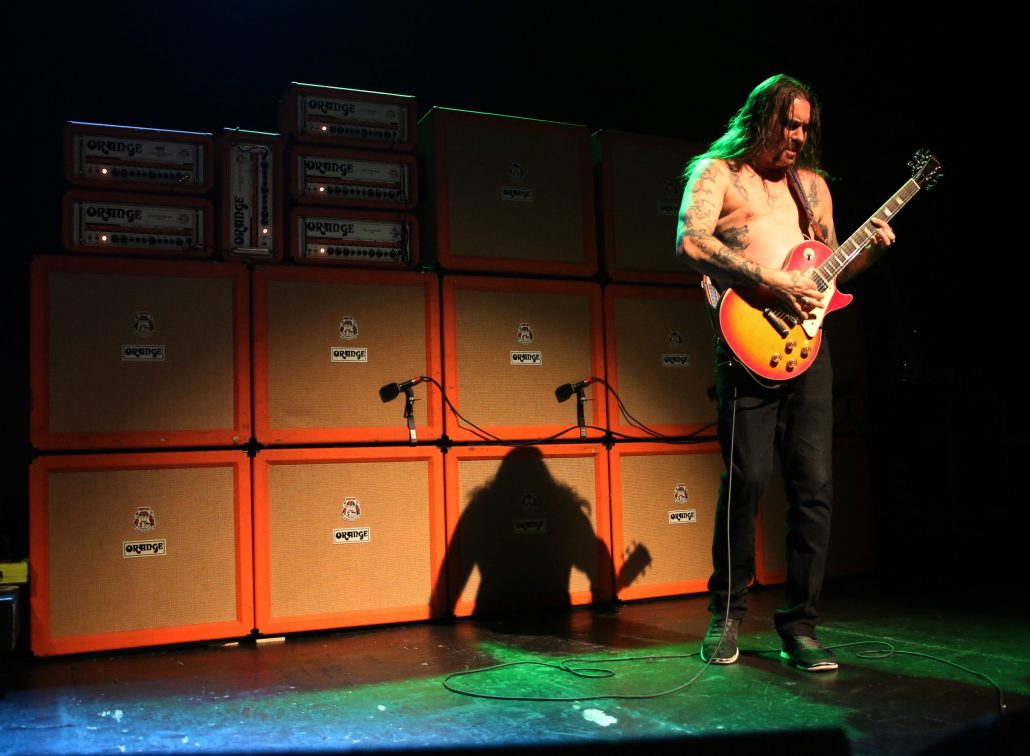
Dual Dark 50
Rockerverb100 MKIII
Crush Mini
PPC412 4×12 Cab
You’re probably not surprised we started this list with Matt Pike, are you? Our favourite shirtless hero and alien expert, singer of songs and player of electric guitars. Whenever Matt Pike comes to town we clear out our backline suppliers within a 50 mile radius before his crew gets given the most exhausting job any road crew has had since the days of Terry Bozzio touring with Frank Zappa. Matt Pike has pioneered doom metal with his band Sleep and become sort of a legend while still alive – he’s also fronting his own band High on Fire which is just as heavy, but faster, like Motörhead. His average Sleep set up normally contains of nine heads, mostly Rockerverbs and Dual Darks, and twelve cabs. Haters will say they ain’t all plugged in, but haters are wrong. For those of you who’s ever been lucky enough to attend a Sleep show and have had the same religious out of body experience as oh so many others while watching Matt Pike tear shit up, you know they’re plugged in and turned up to 11. He also has a dog, and we LOVE dogs over here at Orange.
Monolord, Thomas & Mika
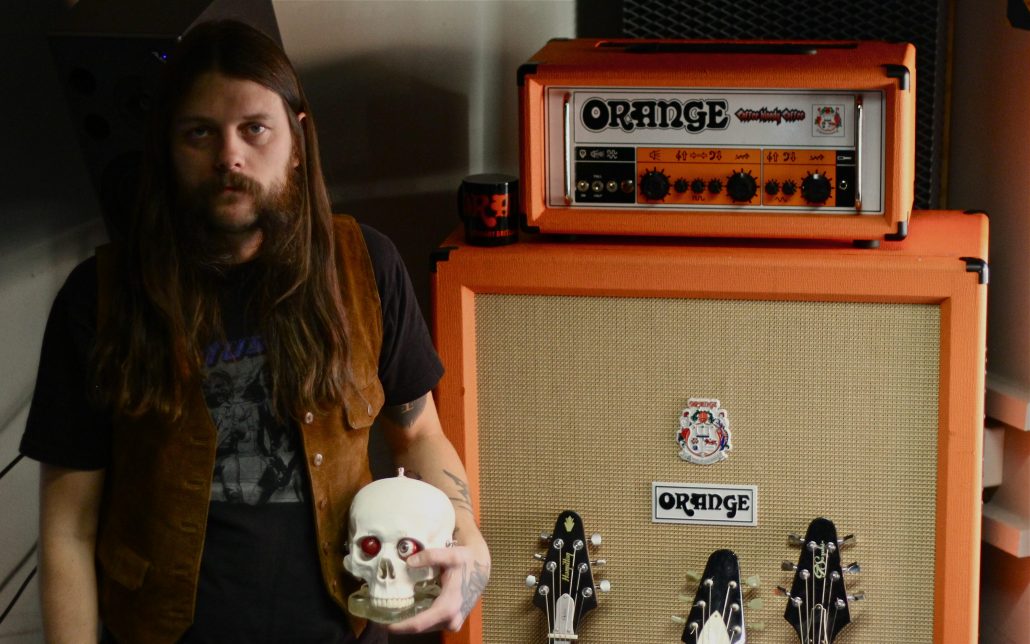
Crush Mini
Rockerverb 100 MKIII Head
PPC412 Speaker Cab
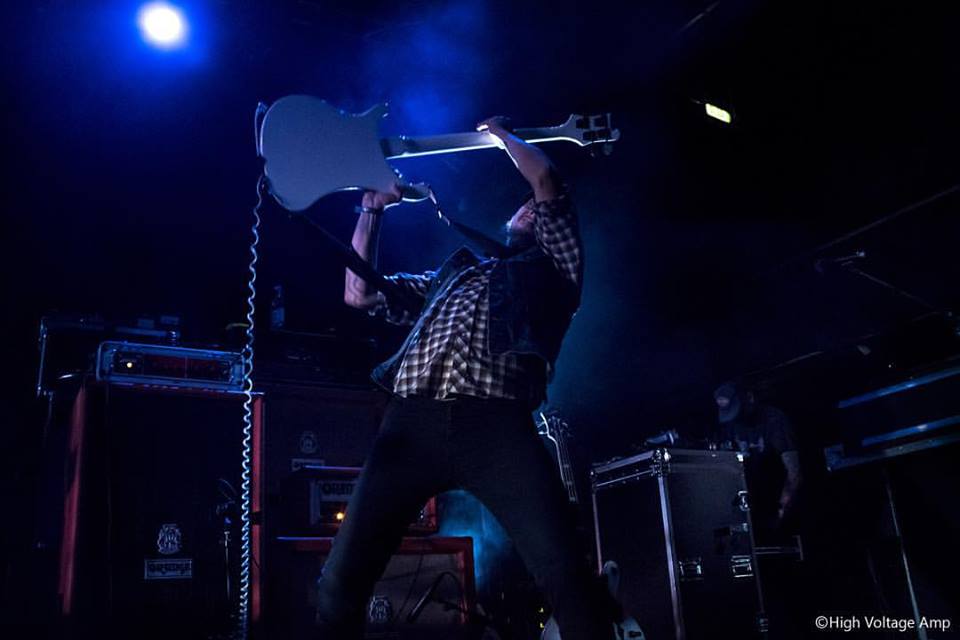
OB1-500
OBC810 8×10 Bass Speaker
We have been avid Monolord supporters here at Orange for years now, and have enjoyed seeing the band grow and develop from playing Camden’s Underworld, to be one of the bands closing Desertfest London on the Sunday at the iconic Roundhouse. The Swedish doom vikings have proven themselves to be masters of their kind, and one of many exceptional bands coming out of Gothenburg in the past years. When asking singer and guitarist Thomas V Jäger what the reason behind this Gothenburg explosion could be, he simply replied: “Have you been there, to Sweden? It’s dark as hell and it always rains, no one ever wants to leave their house so instead they stay in and practice their instrument.”, which only leads us to believe that this is the real deal, pure Nordic doom fuelled by darkness.
Boris, Wata
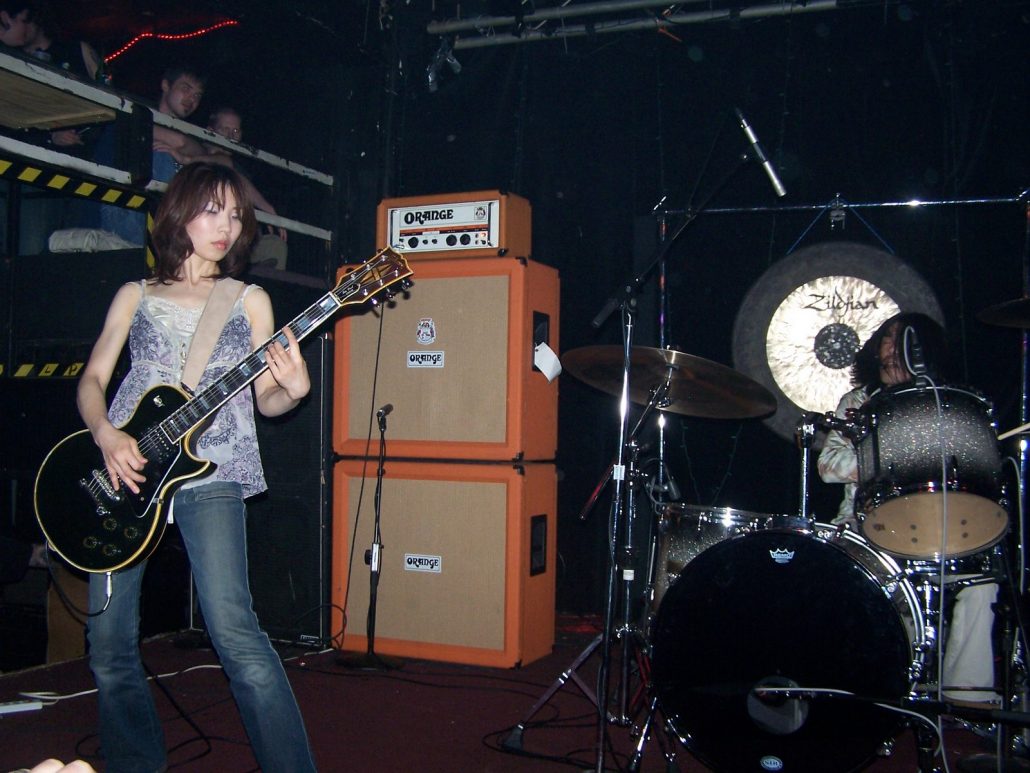
Rockerverb 100 MKIII Head
PPC412 Speaker Cab
At the start of their career 27 years ago, Boris began as a hard core punk act, before venturing into the unknown touching base with drone, doom, and experimental metal. Guitarist Wata is a proud Orange ambassador, and claims that she wouldn’t be where she is today wasn’t it for our brightly coloured amps; “The first amplifier that I purchased was Orange OR-120. Its loud orange color and cute design lured me to try out the model. Contrary to its look, I was astonished by super loud yet warm sound, and the mid-to-low frequencies that shook my body! I still use it to this day. I am extremely grateful for your support when we tour many countries. Orange amps have become my trademark. Orange amps are so compatible with my favourite Les Paul and fuzz pedal that my musical career would not exist without Orange amps.”
Weedeater, Dixie Dave

Weedeater’s Dixie Dave, who on the band’s Facebook page claims “We do what we can’t!” is another doom connoisseur holding the sweet Orange amps close to heart as he “Loves the tone and ass-kicking rumble.” Last I saw of Dixie Dave was in the AMs at the closing party at last year’s Desertfest London where I’d earlier seen them deliver an impeccable performance at the Electric Ballroom, which was the first and last time I saw them with the incredible drummer Carlos Denogean who tragically passed away later in the year. Despite these tragic events, Weedeater is still going strong, with previous drummer Travis “T-Boogie” back behind the drums.
Conan, Jon Davis
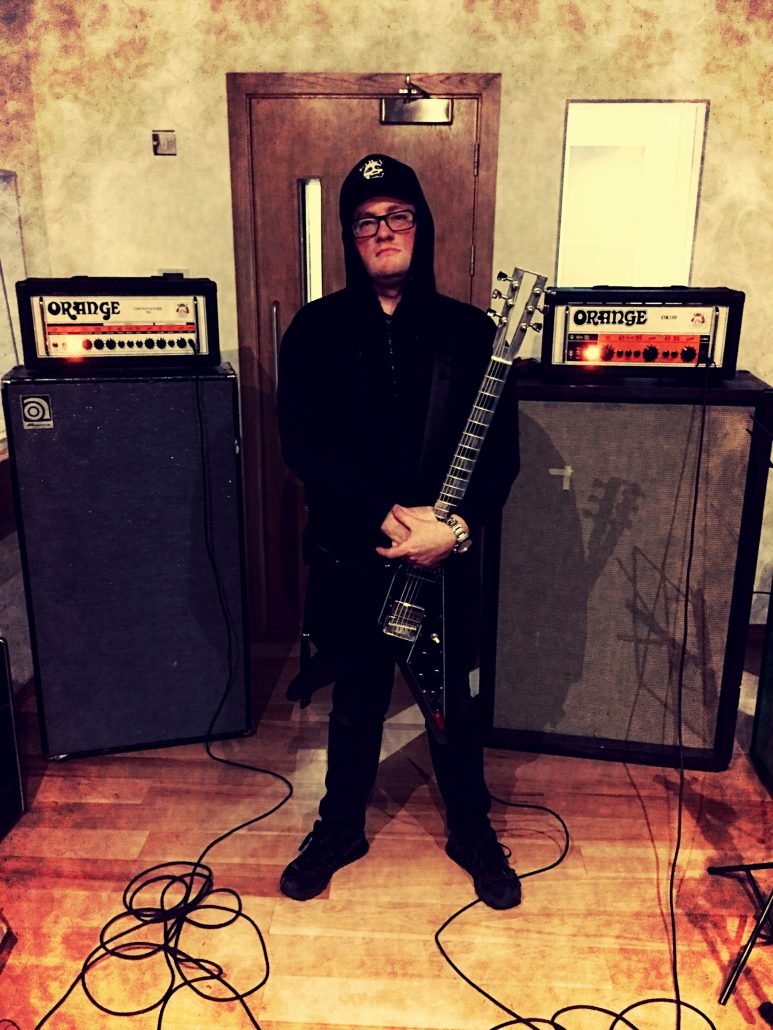
Thunderverb 200 Head
OR100 Head
Liverpool based band Conan’s Joe Davis first fell for the Orange tone using some vintage Orange heads; “I’ve been using some excellent vintage amps for several years, including some old Orange heads. I wanted to buy some modern amps that give me the tone and warmth of the vintage heads I have become accustomed to. I’ve used several modern Orange heads at festivals and these have included the Thunderverb 200, the OR50 and OR100. I was initially curious about the sound and then became pretty much hooked on them. They have all the warmth of the older amps I like, but none of the reliability issues.”
Amp mistreatment is a serious issue plaguing the rock star community. Once you’ve seen what these people are capable of doing to their $2000+ amps you start to wonder what they might be capable of doing to the people they love. It’s an important issue that I want to shed some light on, if for no other reason than to ensure future rock stars won’t repeat their hero’s missteps.
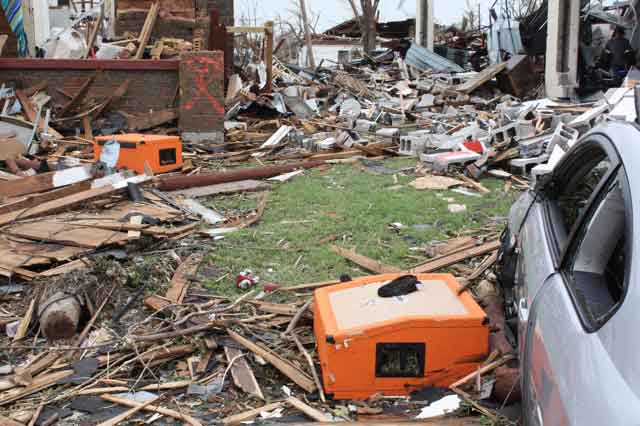
Here are 5 true stories of amp abuse. Together we can end the tragedy that is becoming amplifiers:
The Panties in the Combo Incident
About 10 years ago, I was minding my own business in the customer service office at Orange, just chilling and noshing a banana, when out of nowhere I was called to the warehouse to inspect an artist combo that had been returned due to “unknown default.” I tested it and sure enough, it wasn’t playable. It was a real headscratcher until I looked in the back and noticed a pair of women’s panties had found their way into the area between the chassis and the speakers. Somehow, they had partially melted to the chassis. I called the artist to notify them of the issue and was met with a discouraging tone. They only cared about making sure I didn’t tell their wife.
No care for the combo was demonstrated despite the obvious abuse it had endured. It was a sad day.
The Dr Pepper Incident
We once got an amp back that wasn’t working and when we opened it up the soda was literally burned onto the board. It had probably been there for half the tour. It was then I remembered going to the artist’s show prior when they were slamming their guitar into the speaker cab to make cool noises. There was a Dr Pepper on top – the artist’s preferred drink – and it was splashing around. Not a big deal for a speaker cab, but I recalled thinking to myself at the time “I hope they never do that when the soda is on top of the amp.”
They did. Several times. It was as if the amp had been crying when we opened it up. Crying Dr Pepper.
The Weed In The Cab Incident
Hey, fun fact: if you stuff your entire speaker cab with 10 pounds of weed, it won’t sound as good. In fact, it will sound muffled and more than likely will result in additional heat, with no way to disperse it, which can result in speaker coil damage. Moreover, when you run a 200-watt amp through it while it’s stuffed with weed the overheating can actually burn through the plastic bag containing the weed and, thus, burn your weed.
Now if this doesn’t sound real that’s because it doesn’t sound real. Why would you stuff a cab with weed and then despite the shitty tone, despite the fact it smells as if it is burning, continue to play the cab for an ENTIRE TOUR? That is a great question and one that answered with this response: “Because people kept giving me weed so I didn’t need to smoke any of mine.” Of course that doesn’t answer the question “why did you need 10 pounds of weed?,” but it’s close as we’re going to get to figuring out why this artist would subject their gear to such horrible living conditions.
The Throwing All Their Shit On The Ground Incident
There is no feeling as terrible in the world as watching an artist you trust, one that you’ve shared a beer with, blatantly mistreat their amps in front of you when there’s no recourse. This is exactly what happened on a festival stage in 2015 when a band I had just given free gear to decided that their live experience had been so fantastic that it warranted them pushing over their full stacks. The rage in their eyes, I’ll never forget it. They brutally kicked and punched their amps until all of them were on the stage floor in a pile. Then they turned to me, smiled, and gave me a thumbs-up. It was as if they were trying to implicate me in this travesty. I refused to be their accomplices though.
Upon exiting the stage I told them “great show” through teary eyes. Then we drank a Jagerbomb and the rest is somewhat blurry.
The Bullet Holes Incident
Back in 2012 I was a fresh young Artist Relations rep with all the hope in the world. I woke up to birds singing, showered with lavender soaps, and took the time to put on actual pants. That all changed with one simple email from a up and coming metal band.
They were a hot band on the scene. Cool guys with long hair and jean vests. I wanted them on the artist roster but they wanted a loan of gear for a tour and I didn’t think I had the budget. I went to bat and got it approved but it was definitely “all on me” to ensure nothing bad happened to the gear. The outbound shipment went smooth. The tour was a sell out and that meant many in-person impressions for Orange amps. Everything seemed normal until the band started demonstrating a weird pattern of verbal abuse through emails. Things like “we love the amps but we’re not sure they’re for us.” I couldn’t figure out they were implying. Did they not love me anymore? Were they cheating on me with other amp companies? It was a tough time in my life. The worst 2 weeks ever, you might say.
Finally, I cut the string. I said “I’ve had enough” and requested they return the gear. After what seemed like a months-long hostage negotiation, they signed the papers and I sent a freight company to collect the items. I never could have prepared myself for what happened next. The gear came back and when I opened the first box I noticed a hole in the grill cloth of a speaker cab. As I lifted that cardboard box higher, another hole. Then another and another. Four speaker cabs and four amps had been murdered. The weapon? A rifle, likely an AR15 from the size of the entry points and the exit wounds. It was an absolute massacre.
We held a short ceremony in the warehouse for the gear before burying it in a dumpster out back. The gear didn’t give its life for nothing though. We scrapped it for parts, thus giving life to other amps. There’s no excuse for not being a parts donor!
